tire pressure Lexus IS250 2012 Using the air conditioning system and defogger / LEXUS 2012 IS250,IS350 (OM53A87U) Owner's Guide
[x] Cancel search | Manufacturer: LEXUS, Model Year: 2012, Model line: IS250, Model: Lexus IS250 2012Pages: 592, PDF Size: 6.2 MB
Page 478 of 592

478
5-2. Steps to take in an emergency
CAUTION
■When the electric power steering warning light comes on
The steering wheel may become extremely heavy.
If the steering wheel becomes heavier than usual when operating, firmly hold and
operate it using more force than usual.
■If the tire pressure warning light comes on
Be sure to observe the following precautions. Failure to do so could cause loss of
vehicle control and result in death or serious injury.
●Stop your vehicle in a safe place as soon as possible. Adjust the tire inflation pres-
sure immediately.
●If the tire pressure warning light comes on even after tire inflation pressure adjust-
ment, it is probable that you have a flat ti re. Check the tires. If the tire is flat,
change to the spare tire and have the flat tire repaired by the nearest Lexus
dealer.
●Avoid abrupt maneuvering and braking. If the vehicle tires deteriorate, you could
lose control of the steering wheel or the brakes.
■If a blowout or sudden air leakage should occur
The tire pressure warning system may not activate immediately.
Page 479 of 592
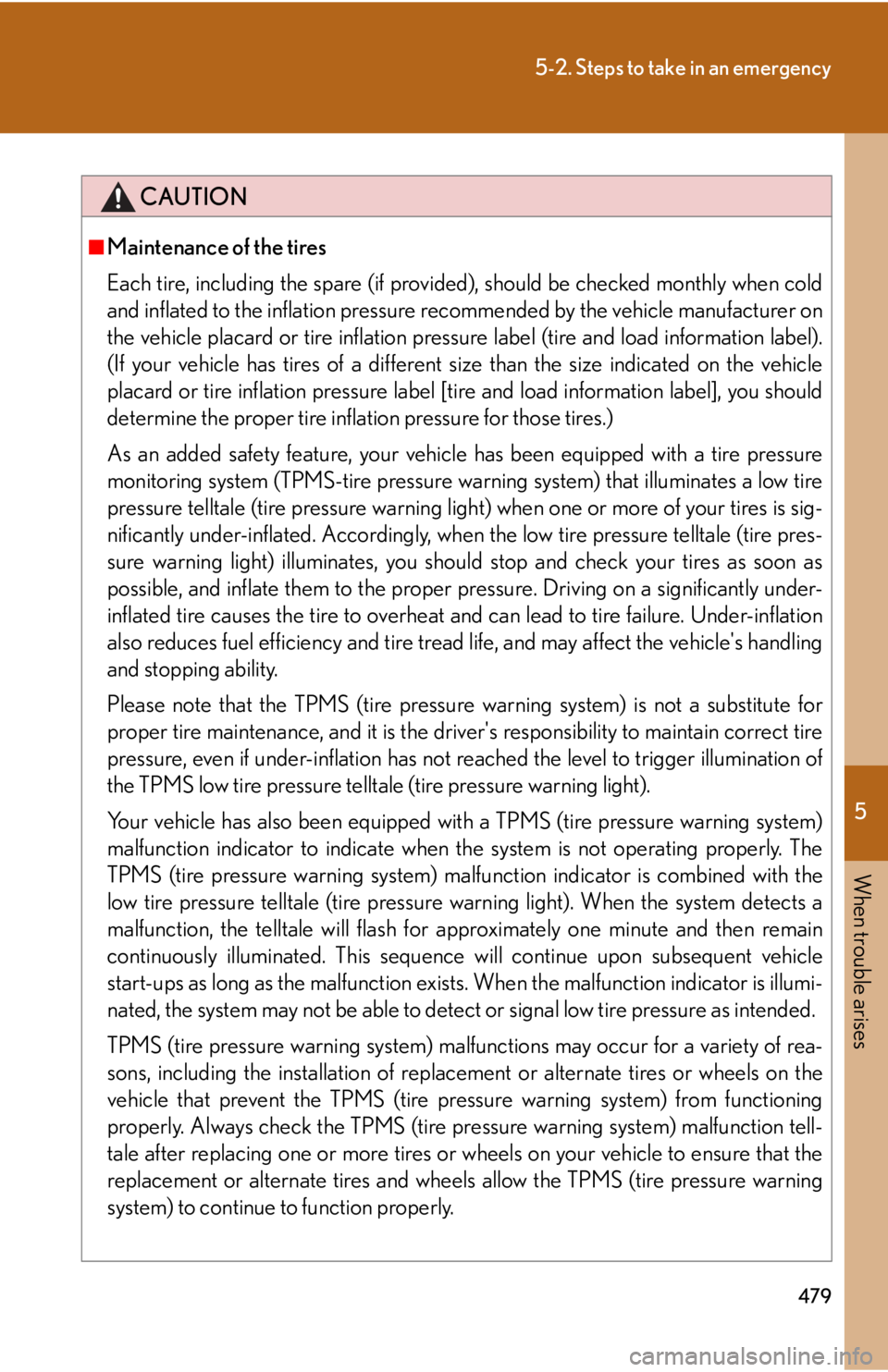
5
When trouble arises
479
5-2. Steps to take in an emergency
CAUTION
■Maintenance of the tires
Each tire, including the spare (if provided), should be checked monthly when cold
and inflated to the inflation pressure re commended by the vehicle manufacturer on
the vehicle placard or tire inflation pressure label (tire and load information label).
(If your vehicle has tires of a different size than the size indicated on the vehicle
placard or tire inflation pressure label [tire and load information label], you should
determine the proper tire inflation pressure for those tires.)
As an added safety feature, your vehicl e has been equipped with a tire pressure
monitoring system (TPMS-tire pressure warning system) that illuminates a low tire
pressure telltale (tire pressure warning light) when one or more of your tires is sig-
nificantly under-inflated. Accordingly, when the low tire pressure telltale (tire pres-
sure warning light) illuminates, you should stop and check your tires as soon as
possible, and inflate them to the proper pressure. Driving on a significantly under-
inflated tire causes the tire to overheat an d can lead to tire failure. Under-inflation
also reduces fuel efficiency and tire tread life, and may affect the vehicle's handling
and stopping ability.
Please note that the TPMS (tire pressure warning system) is not a substitute for
proper tire maintenance, and it is the driver's responsibility to maintain correct tire
pressure, even if under-inflation has not reached the level to trigger illumination of
the TPMS low tire pressure telltale (tire pressure warning light).
Your vehicle has also been equipped with a TPMS (tire pressure warning system)
malfunction indicator to indicate when th e system is not operating properly. The
TPMS (tire pressure warning system) malf unction indicator is combined with the
low tire pressure telltale (tire pressure warning light). When the system detects a
malfunction, the telltale will flash for approximately one minute and then remain
continuously illuminated. This sequence will continue upon subsequent vehicle
start-ups as long as the malfunction exists . When the malfunction indicator is illumi-
nated, the system may not be able to detect or signal low tire pressure as intended.
TPMS (tire pressure warning system) malfunctions may occur for a variety of rea-
sons, including the installation of replacem ent or alternate tires or wheels on the
vehicle that prevent the TPMS (tire pressure warning system) from functioning
properly. Always check the TPMS (tire pressure warning system) malfunction tell-
tale after replacing one or more tires or wheels on your vehicle to ensure that the
replacement or alternate tires and wheels allow the TPMS (tire pressure warning
system) to continue to function properly.
Page 480 of 592

480
5-2. Steps to take in an emergency
NOTICE
■Precaution when installing a different tire
When a tire of a different specification or maker is installed, the tire pressure warn-
ing system may not operate properly.
Page 496 of 592

496
5-2. Steps to take in an emergency
Install the spare tire and loosely
tighten each nut by hand to
approximately the same amount.
Tighten the wheel nuts until the
tapered portion comes into loose
contact with the disc wheel seat.
Lower the vehicle.
Firmly tighten each nut two or
three times in the order shown in
the illustration.
Tightening torque:
76 ft•lbf (103 N•m, 10.5 kgf•m)
Stow the flat tire, tire jack and all tools.
STEP2
Disc wheel
seat
Tapered portion
STEP3
STEP4
■The compact spare tire
●The compact spare tire is identified by the label “TEMPORARY USE ONLY”
on the tire sidewall.
Use the compact spare tire temporarily only in an emergency.
●Make sure to check the tire pressure of the compact spare tire. (
P. 5 3 1 )
STEP5
Page 497 of 592

5
When trouble arises
497
5-2. Steps to take in an emergency
■When using the compact spare tire
As the compact spare tire is not equipped with the tire pressure warning valve and
transmitter, low inflation pressure of the spare tire will not be indicated. Also, if you
replace the compact spare tire after the tire pressure warning light comes on, the
light remains on.
■If you have a flat rear tire on a road covered with snow or ice
Install the compact spare tire on the front of the vehicle. Perform the following steps
and fit tire chains to the rear tires.
Replace a front tire with the compact spare tire.
Replace the flat rear tire with the tire removed from the front of the vehi-
cle.
Fit tire chains to the rear tires.
■After completing the tire change
The tire pressure warning system must be reset. ( P. 4 1 4 )
CAUTION
■Using the tire jack
Improper use of the tire jack may lead to death or serious injuries due to the vehicle
suddenly falling off the jack.
●Do not use the tire jack for any purpose other than replacing tires or installing and
removing tire chains.
●Only use the tire jack that comes with this vehicle for replacing a flat tire.
Do not use it on other vehicles, and do no t use other tire jacks for replacing tires
on this vehicle.
●Always check that the tire jack is securely set to the jack point.
●Do not put any part of your body under the vehicle while it is supported by a jack.
●Do not start or run the engine while your vehicle is supported by the jack.
●Do not raise the vehicle while someone is in it.
●When raising the vehicle, do not put an object on or under the jack.
●Do not raise the vehicle to a height greate r than that required to replace the tire.
STEP1
STEP2
STEP3
Page 500 of 592

500
5-2. Steps to take in an emergency
NOTICE
■Do not drive the vehicle with a flat tire.
Do not continue driving with a flat tire.
Driving even a short distance with a flat tire can damage the tire and the wheel
beyond repair.
■Be careful when driving over bumps with the compact spare tire installed on the
vehicle.
The vehicle becomes lower when driving with the compact spare tire compared to
when driving with standard tires. Be careful when driving over uneven road sur-
faces.
■Driving with tire chains and the compact spare tire
Do not fit tire chains to the compact spare tire.
Tire chains may damage the vehicle body and adversely affect driving performance.
■When replacing the tires
When removing or fitting the wheels, tire s or the tire pressure warning valve and
transmitter, contact your Lexus dealer as the tire pressure warning valve and trans-
mitter may be damaged if not handled correctly.
■To avoid damage to the tire pressure warning valves and transmitters
When a tire is repaired with liquid seal ants, the tire pressure warning valve and
transmitter may not operate properly. If a liquid sealant is used, contact your Lexus
dealer or other qualified service shop as so on as possible. Make sure to replace the
tire pressure warning valve and transmitter when replacing the tire. ( P. 4 1 4 )
Page 531 of 592
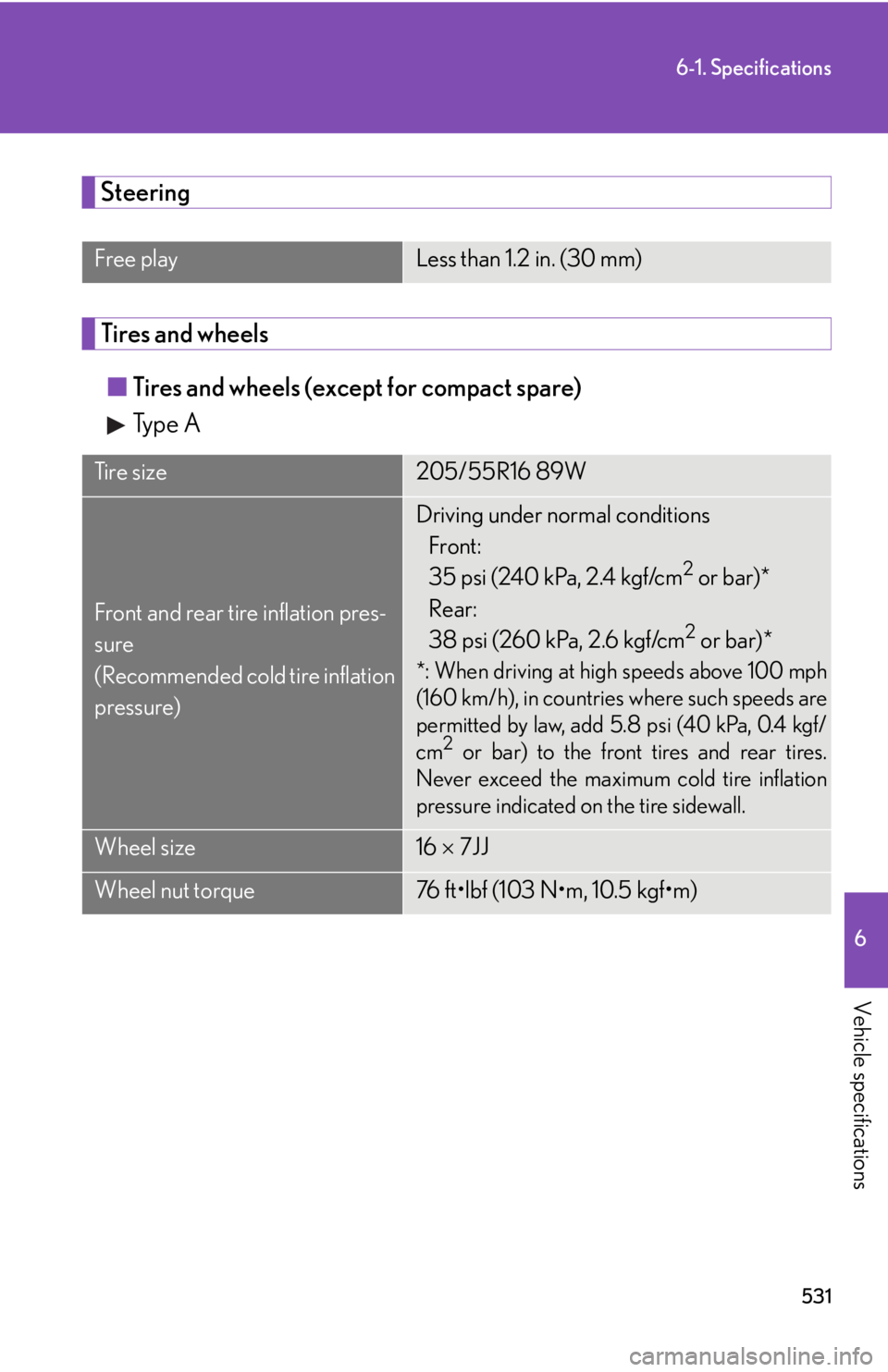
531
6-1. Specifications
6
Vehicle specifications
Steering
Tires and wheels■ Tires and wheels (except for compact spare)
Type A
Free playLess than 1.2 in. (30 mm)
Ti r e s i z e205/55R16 89W
Front and rear tire inflation pres-
sure
(Recommended cold tire inflation
pressure)
Driving under normal conditions
Front:
35 psi (240 kPa, 2.4 kgf/cm
2 or bar)*
Rear:
38 psi (260 kPa, 2.6 kgf/cm
2 or bar)*
*: When driving at high speeds above 100 mph
(160 km/h), in countries where such speeds are
permitted by law, add 5.8 psi (40 kPa, 0.4 kgf/
cm
2 or bar) to the front tires and rear tires.
Never exceed the maximum cold tire inflation
pressure indicated on the tire sidewall.
Wheel size16 7JJ
Wheel nut torque76 ft•lbf (103 N•m, 10.5 kgf•m)
Page 532 of 592
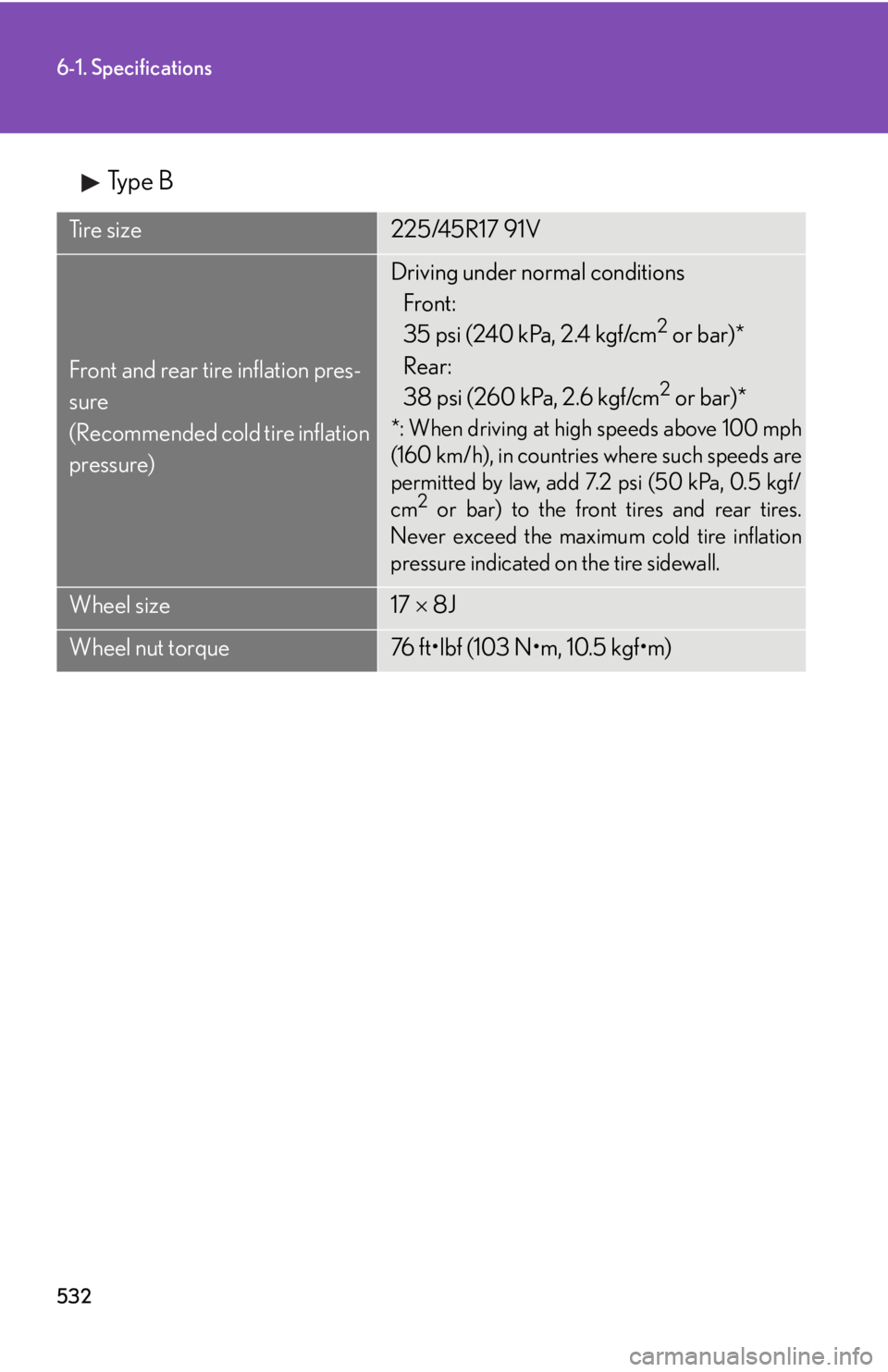
532
6-1. Specifications
Type B
Ti r e s i z e225/45R17 91V
Front and rear tire inflation pres-
sure
(Recommended cold tire inflation
pressure)
Driving under normal conditions Front:
35 psi (240 kPa, 2.4 kgf/cm
2 or bar)*
Rear:
38 psi (260 kPa, 2.6 kgf/cm
2 or bar)*
*: When driving at high speeds above 100 mph
(160 km/h), in countries where such speeds are
permitted by law, add 7.2 psi (50 kPa, 0.5 kgf/
cm
2 or bar) to the front tires and rear tires.
Never exceed the maximum cold tire inflation
pressure indicated on the tire sidewall.
Wheel size17 8J
Wheel nut torque76 ft•lbf (103 N•m, 10.5 kgf•m)
Page 533 of 592
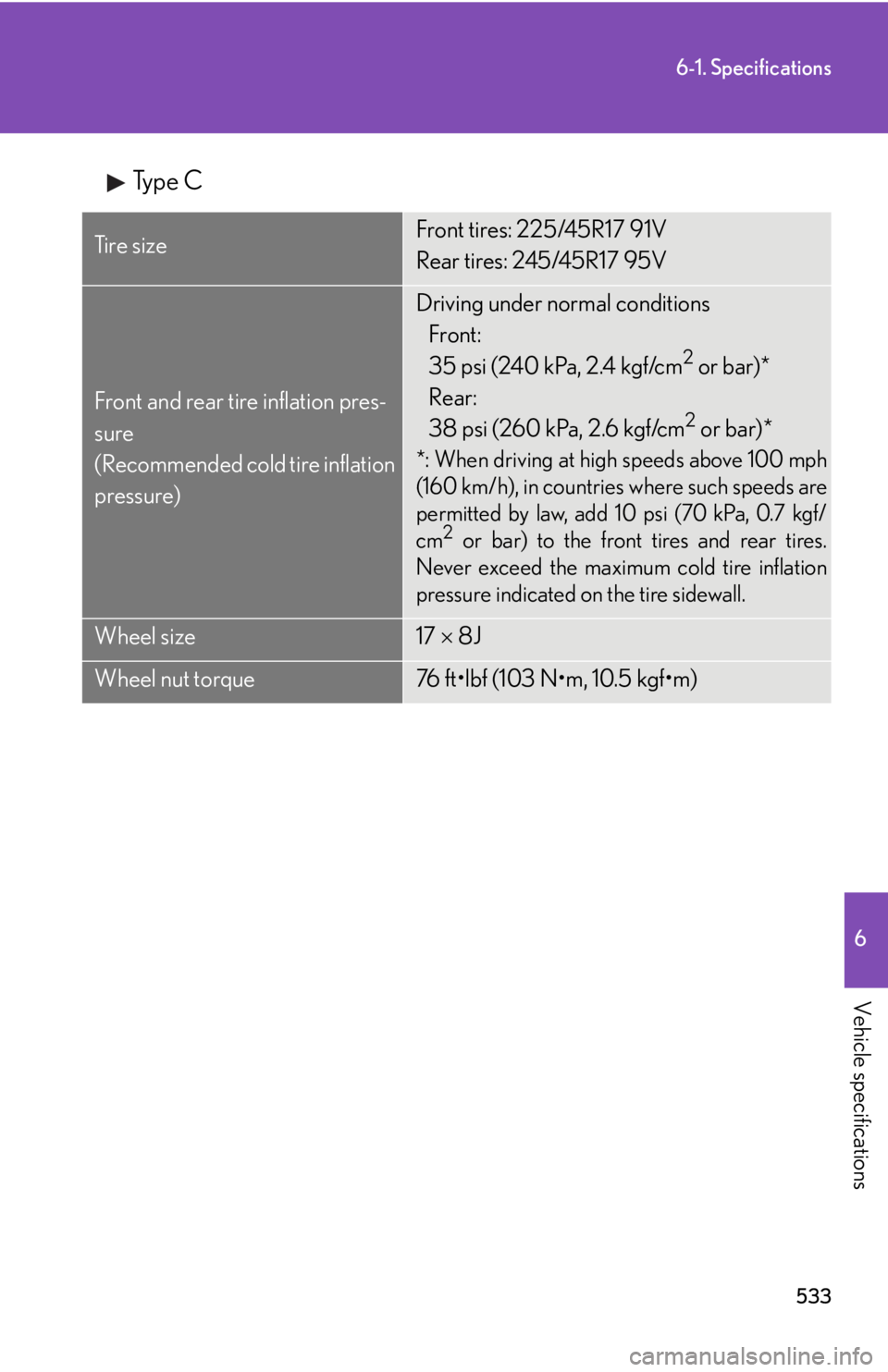
533
6-1. Specifications
6
Vehicle specifications
Type C
Ti r e s i z eFront tires: 225/45R17 91V
Rear tires: 245/45R17 95V
Front and rear tire inflation pres-
sure
(Recommended cold tire inflation
pressure)
Driving under normal conditionsFront:
35 psi (240 kPa, 2.4 kgf/cm
2 or bar)*
Rear:
38 psi (260 kPa, 2.6 kgf/cm
2 or bar)*
*: When driving at high speeds above 100 mph
(160 km/h), in countries where such speeds are
permitted by law, add 10 psi (70 kPa, 0.7 kgf/
cm
2 or bar) to the front tires and rear tires.
Never exceed the maximum cold tire inflation
pressure indicated on the tire sidewall.
Wheel size17 8J
Wheel nut torque76 ft•lbf (103 N•m, 10.5 kgf•m)
Page 534 of 592
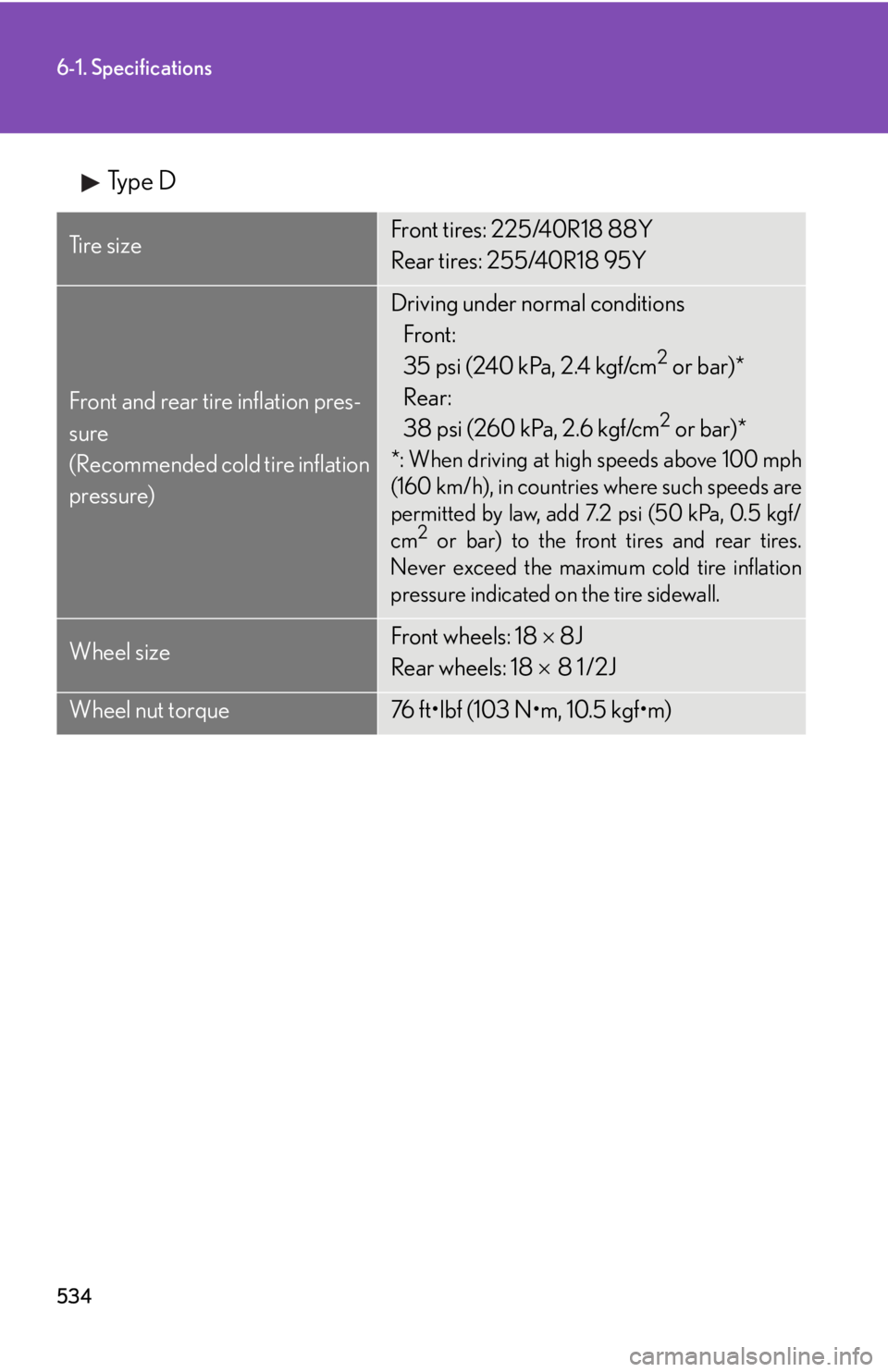
534
6-1. Specifications
Type D
Ti r e s i z eFront tires: 225/40R18 88Y
Rear tires: 255/40R18 95Y
Front and rear tire inflation pres-
sure
(Recommended cold tire inflation
pressure)
Driving under normal conditions Front:
35 psi (240 kPa, 2.4 kgf/cm
2 or bar)*
Rear:
38 psi (260 kPa, 2.6 kgf/cm
2 or bar)*
*: When driving at high speeds above 100 mph
(160 km/h), in countries where such speeds are
permitted by law, add 7.2 psi (50 kPa, 0.5 kgf/
cm
2 or bar) to the front tires and rear tires.
Never exceed the maximum cold tire inflation
pressure indicated on the tire sidewall.
Wheel sizeFront wheels: 18 8J
Rear wheels: 18 8 1 /2J
Wheel nut torque76 ft•lbf (103 N•m, 10.5 kgf•m)